Do you know all varieties of Anthurium have an unique flower that actually is not a flower but the spathe of the plant?
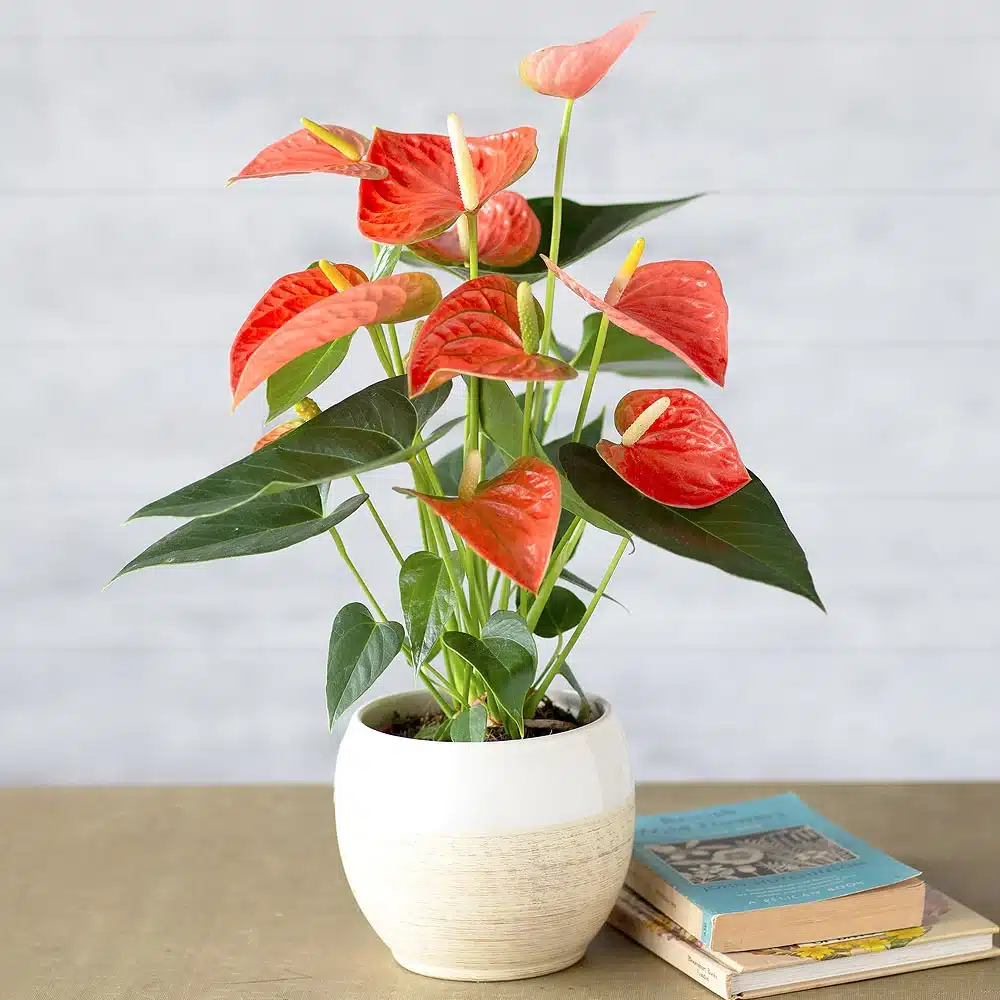
All these varieties can be differentiated by colors, shapes, patterns, etc., while some are closely related and share the exact resemblance.
We have amassed a list of Anthuriums for you to choose from. Let’s dive straight into the article.
Table of Contents Show
25 Highly LOVED Anthurium Varieties
Anthurium is a beautiful plant that prefers USDA zone 10-11 but can sustain up to 13.
Did you know? The name Anthurium (an·thaw·ree·uhm) is derived from the Greek words ‘Anthos’ and ‘Oura,’ which basically means “Tail Flower.”
Due to the number of varieties Anthurium has, it was hard to make a choice while preparing this list for you. But here we are with a list of the most loved ones.
1. Anthurium Splendidum
Just like its name, this variety of Anthurium is actually splendid. It is a rare but popular plant that has made its name among plant enthusiasts.
Their leaves are the main attraction of this plant. They can grow up to the size of the plant itself.

The plant growth speed is actually faster compared to other plants as Anthurium splendidum can grow up to a size of up to 4 feet within two years.
The peculiar thing about this plant is that its leaves are covered in scales, providing it with a mesmerizing look.
However, the bottom part of the leaf is not as pleasing as the upper part.
2. Anthurium Cobra
Anthurium cobra is one of the most intriguing Anthurium varieties.
It is the subspecies of Anthurium bonplandii, and its scientific name is Anthurium bonplandii subsp. guayanum.
This plant is incredibly strong and can be a great addition to decorating your home and office.
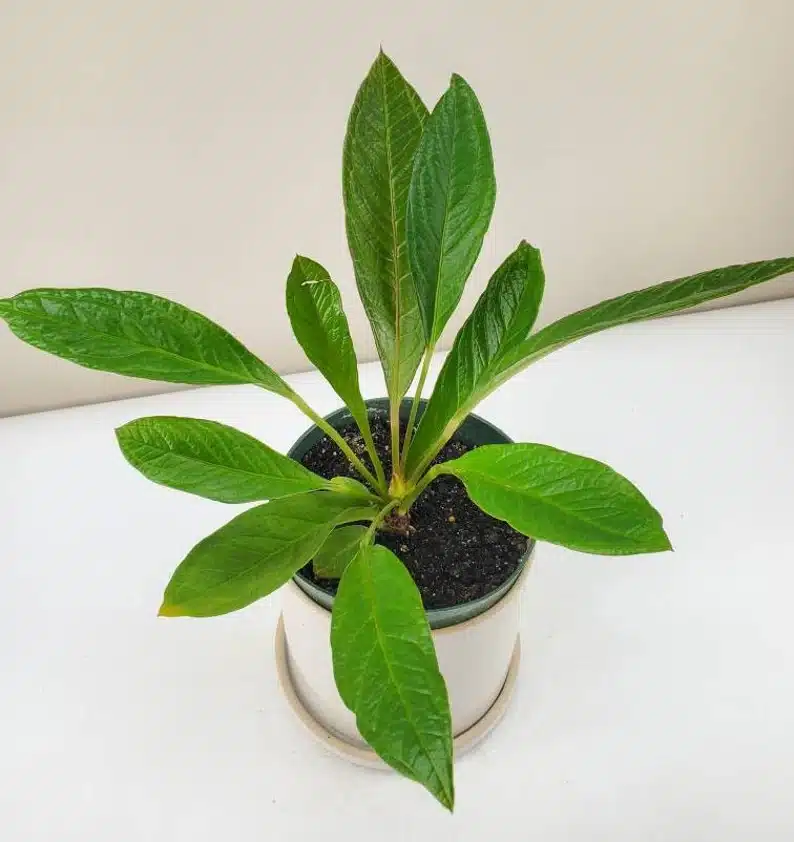
Cobra is a slow grower plant, and it takes up to one growing season to even reach 2 feet. Under favorable conditions, this plant can grow up to 5 feet, i.e., in their natural habitat.
Like most Anthuriums, this variety is also famous for its distinct leaves. The leaves are boarded and elongated with a leather-like solid appearance.
The lower part of the leaves has a reddish color when they are young and darkens with the plant’s maturity.
Flowers on Anthurium cobra are something that is not worth discussing.
Though Anthurium cobra blooms once a year during the spring season and can live up to six weeks, it is more likely to be known for its foliage.
3. Anthurium Polyschistum
Polyschstum is a strange variety of Anthurium that looks like a palm or a hemp plant but is a vining epiphyte.
You may see a polyschistum and confuse it with other plants with palmatisect leaves. A leaf blade of this plant can contain up to 9 leaflets.

The glossy-looking leaves with wavy margins are long and can grow up to 15cm in width, while the entire plant is up to 80 inches long.
The leaves can have dark green to grayish color. Talking about flowers, the Anthurium polyschistum has a spathe that hosts a spadix supported by a peduncle.
They bloom throughout the year, while most of them bloom during the growing seasons of spring and summer.
Did you know? Polyschistum pollinates via birds and winds as they cannot pollinate themselves.
This plant also produces tiny berries that are violet-purple in color. Birds feast on the berries and aid the pollination process.
4. Anthurium Rotundistigmatum
Anthurium rotundistigmatum is another Anthurium variety whose leaves can grow larger than the plant itself. The leaves of this plant are thin, oval-triangular shaped.
They can be up to 26-56cm long and 17-30cm wide. The texture may vary from matte to semi-glossy, depending on the time of the year.

Rotundistigmatum blooms during late spring and summer. The 8 to 13.5cm long spathe is colored reddish-purple, and it changes to reddish-brown with time.
This plant also produces beautiful oval/round berry-like fruits that can be up to 25cm long.
Read more about this plant here: “Anthurium Rotundistigmatum Care — What you Need to Know!”
5. Anthurium Ace of Spades
Anthurium ‘Ace of Spades’ has a unique name that is quite fitting for the plant’s appearance.
This plant’s leaves are shaped like a heart, quite close to the actual ace of spades from the deck of cards.

Patience is the key here! Since you might need to wait for a solid 2-3 years before you get to see a fully grown leaf, as this plant is a slow grower.
The leaves can grow up to be 2 feet wide and 2.5 feet long. They are red when they sprout and eventually turn dark green as they grow.
Even more striking is the veneration the leaves have; they are silvery-white in color and stand out in the dark green background. The plant itself grows up to the height of 3 feet.
It produces flowers that are purplish-brown spathe. They are nothing that plants would be proud of, as they are not “eye-catching,”; but the stunning foliage covers that weakness.
6. Anthurium Plowmanii
One of the Anthurium with the most striking features for many Anthurium lovers is the Anthurium plowmanii.
It has deep green, glossy, and leathery leaves that have wavy edges. The leaves together form a rosette when the plant expands out.
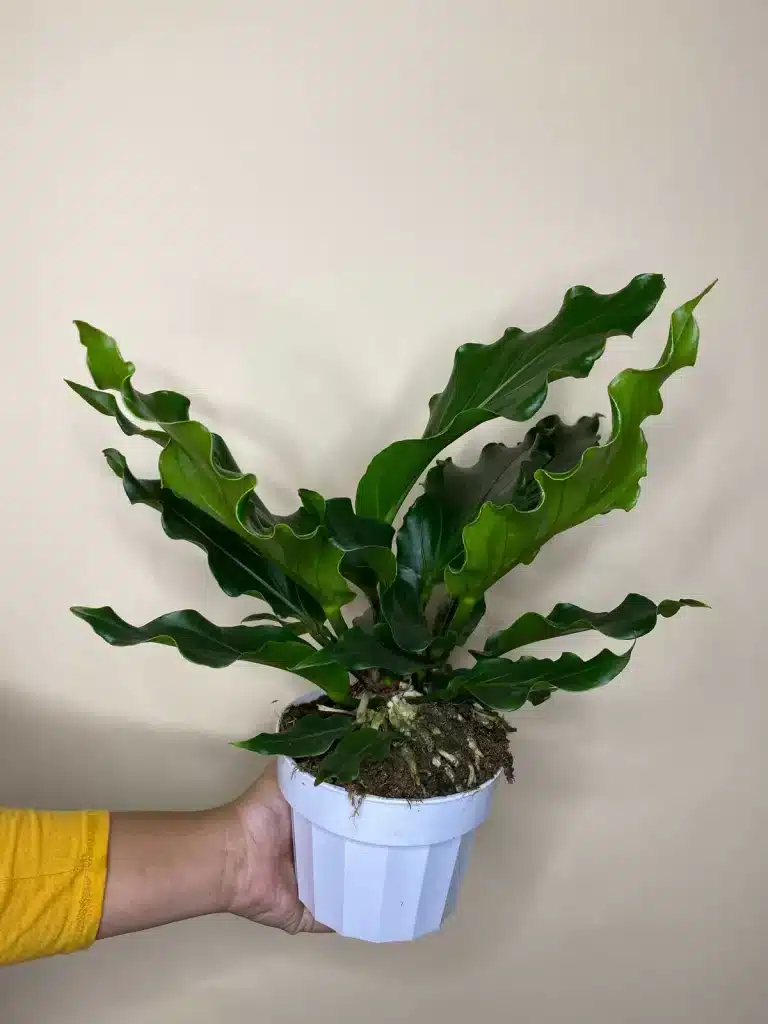
Supported by their large ‘philodendron-esque’ leaves, this plant can grow up to 6 feet tall in its natural habitat.
However, the leaves can grow even bigger, reaching 7 feet in the wild. The growth rate may not be similar in the indoor environment as they grow up to 2 feet indoors.
Sometimes, you may witness yellow variegation on the plant leaves if you’re lucky.
This plant produces greenish blooms every three months with a hint of purple at the base, and the flower lives for nearly two months.
7. Anthurium Bullatus
Anthurium Bullatus is the “go-to” if you are thinking about getting a magnificent decorative plant for your home or office.
This beautiful plant is a hybrid between Anthurium Subsignatum and Anthurium Veitchii.
The plant with an hourglass shape is a fast grower and can attain maximum maturity within 2 years.
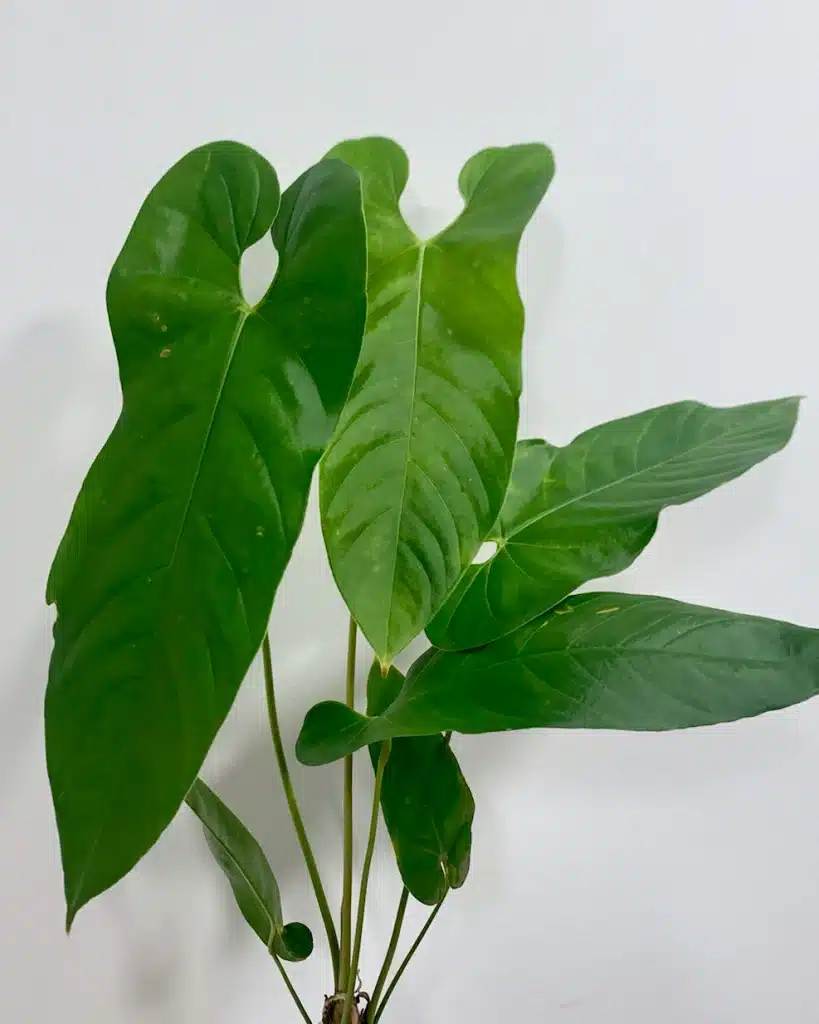
Bullatus can grow up to 4 feet in height, whereas the leaf grows up to 2 feet. The leaves are glossy, dark green, and large, with ruffled edges showcasing waves.
To burst your bubble, This plant doesn’t bloom flowers. So, please do not spend your time waiting for them.
8. Anthurium Metallicum
Now we are reading about one of the varieties of Anthurium famous for its magnificent leaves.
Anthurium metallicum has blade-like leaves that endorse dark green velvety color. The veins are something that is sure to get your attention.
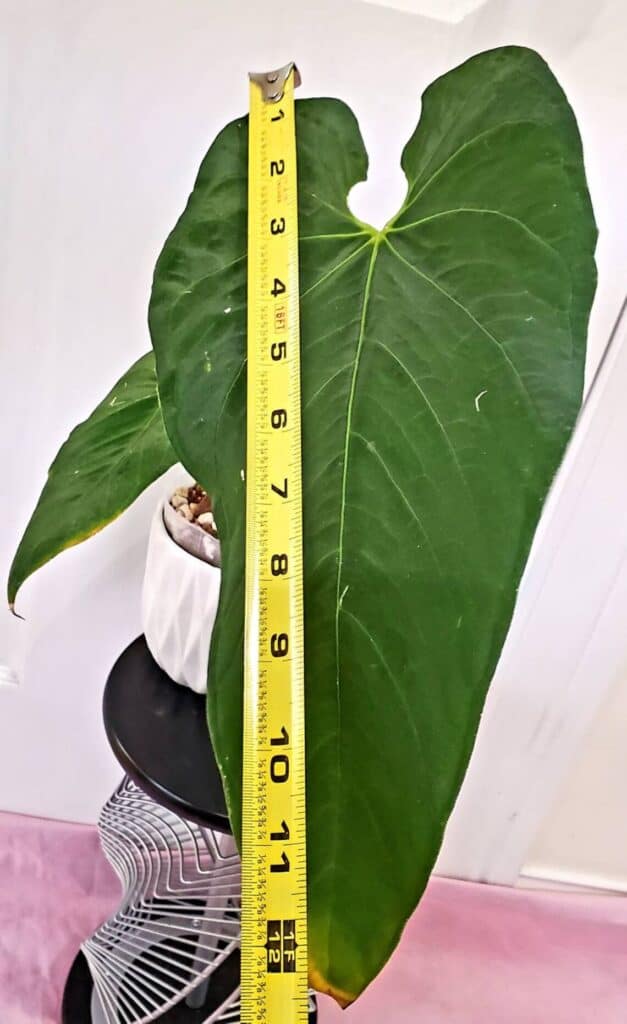
Silvery-white veins run through the middle of the leaf. The plant falls under the category of a slow-intermediate grower.
The leaves can grow up to the size of 10-20 inches, while the plant can grow up to 7 feet if the conditions are right.
Fulfilling the care requirements for this plant, as mentioned in our article “Anthurium Metallicum,” will reward you with up to 5 blooms a year.
The blooms can last up to 2 to 3 months.
9. Anthurium Cutucuense
Anthurium cutucuense is one of the most endangered varieties of Anthurium. You may even need up to $150 to get a baby plant.
This slow grower may take up to a lifetime, i.e., a considerable period of at least 10-15 years, to reach the heights of a mere 2 feet with a width of 3 feet.

Anthurium cutucuense has strange downward foliage with droopy appearances where 3 leaves can grow out of a single node, giving it a bullate look.
The leaves are slender and can grow up to 3 feet. This variety of Anthurium also doesn’t bear any flowers. Thus, provide as much care to the gorgeous foliage as you can.
If you want to know more, we have got you. Read “Anthurium Cutucuense Care Guide- Experts Reveal!“
10. Anthurium Pendens
One of the most exotic plants in the Anthurium family is the Anthurium pendens.
It gives a ‘wind-chime’ appearance if you hang it in a basket above your head. The leaves of this plant will always turn and hang downwards no matter what you do.
Did you Know? Anthurium pendens is known for removing ammonia, formaldehyde, and other harmful chemicals from the air.
Individual leaves look like swords and can be as long as 30 inches and 5 inches wide.

The new leaves of this plant will have a lighter green color that turns darker as the plant matures.
Like most other Anthurium, this plant as well as berry-shaped flowers that grow every three months.
It has a spathe that can be up to 3 inches and a spadix ranging from pink to greenish-brown in color.
11. Anthurium Pendulifolium
This variety of Anthurium shares its similarities with Anthurium pendens.
Anthurium pendulifolium provides you with the option of either hanging them in a basket or potting them in a container according to your needs.
This plant grows at a medium to slow pace. Pendulifolium can be really long as it can grow up to be 25 inches long and 22 inches wide.
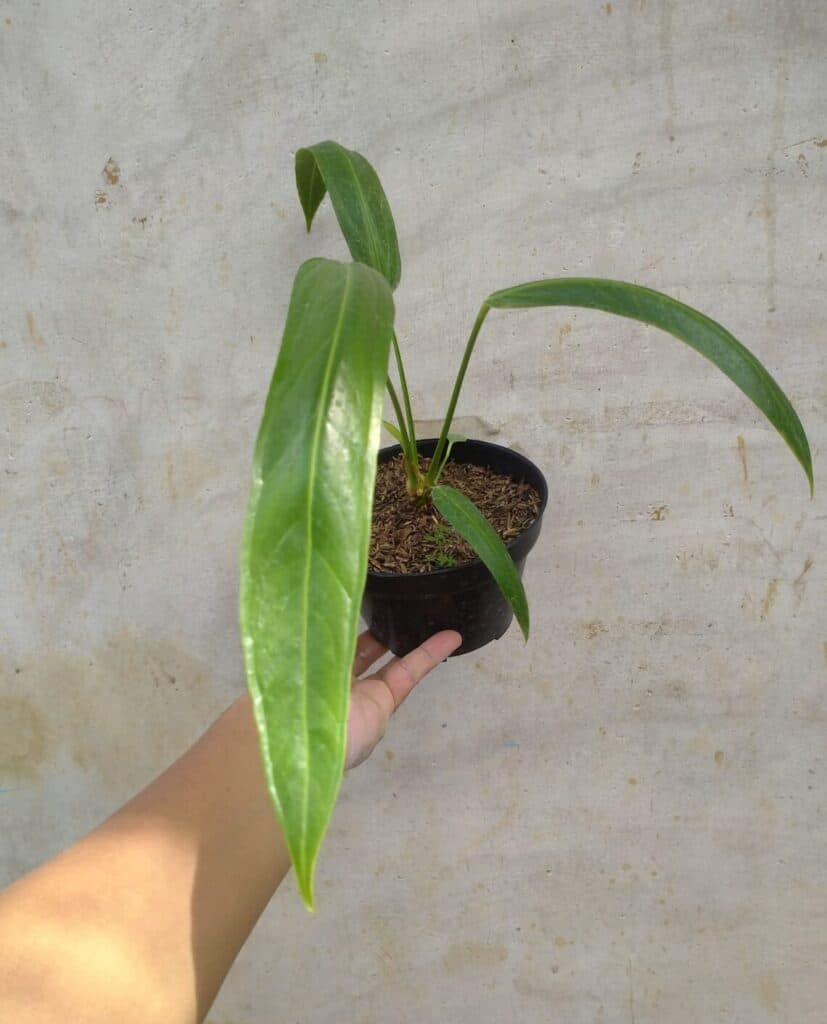
The leaves are lance-shaped, and the top part of the leaf is glossy and green in color, while the bottom part showcases a pale green color and is more matte.
However, with beauty comes the beast. The bloom of this plant is something that will never make its position in the list of “Beautiful Blooms.”
Their long spadix is purple, and the spathe ranges from creamy-white to green color.
12. Anthurium Luxurians
True to its name, Anthurium luxurians is actually a ‘luxury’ houseplant to own, thanks to its leaves.
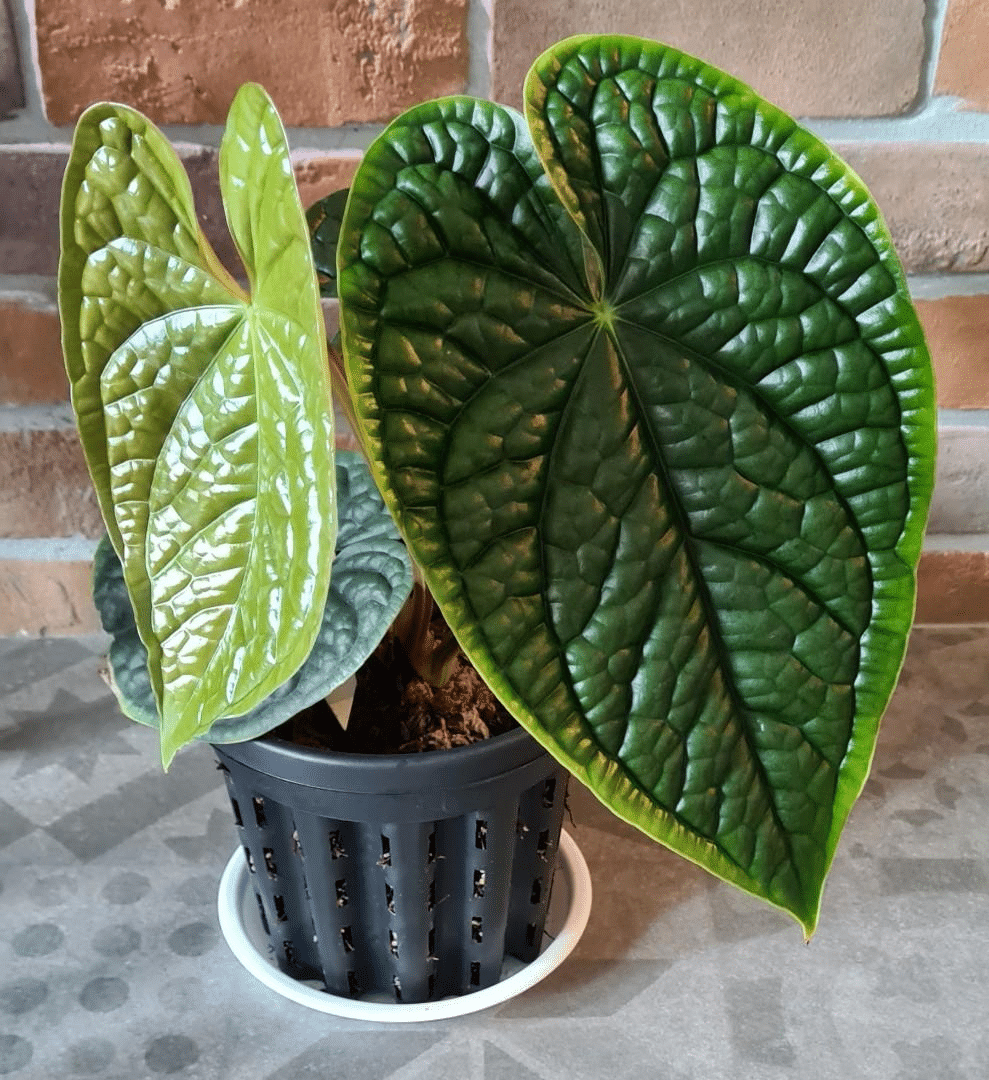
This plant has a moderate growth rate that slows further down during the plant’s dormancy period.
The heart-shaped leaves have a blistery appearance with a light green to golden bronze color that changes into dark green as the plant matures.
Also, the blistering pattern compliments the look of veins in the plant.
It can grow up to the size of 15 inches, while the leaves are up to 23 inches long, and their width is up to 20 inches.
Luxurians bloom throughout the year with creamy white-spathe and pink-red spadix.
13. Anthurium Dorayaki
If you lay your eyes on one of these masterpieces, they are sure to mesmerize you. Anthurium dorayaki boasts one of the most intriguing foliage among Anthuriums.
These plants are oval-shaped and have glossy green colors in the background with white striations.
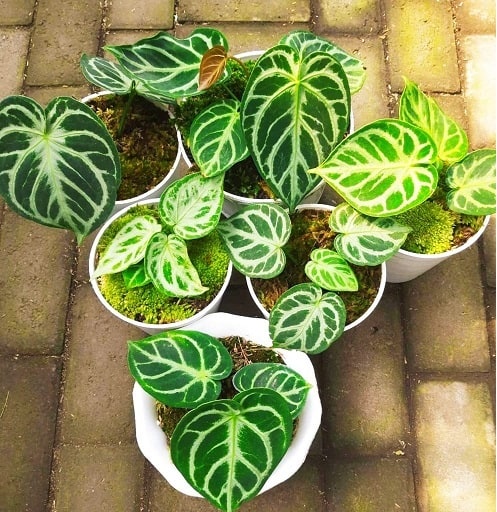
Dorayaki produces leaves sideways, and newly formed leaves take nearly 3 weeks to mature fully.
This bushier-looking plant is a moderate to slow grower. The plant can have a height of about 18 inches and a spread of about 12 inches.
Seeing blooms on these plants when grown indoors is a rare occurrence. You might get lucky to witness flowers if you feed your plant with enough phosphate.
They produce spathe and spadix. The inflorescence is green color.
14. Anthurium Regale
Like its name, Anthurium regale is a majestic-looking plant that will boost your house’s decorative charm.
The leaves are the main attraction as they showcase a heart’s shape that is velvety green in color and yellow-white striations act as “cherry-on-top.”

The plant has a modest growth rate and usually flourishes from spring to fall, growing new leaves every three months.
Regale may take longer to mature than other plants because of its larger leaves.
Araceae plants like Anthuriums have tiny flowers growing on the spadix. Those flowers are so small that they are not clearly visible to our naked eye.
They produce a spathe and a spadix. Many people mistake the spathe for a flower. Since the spathe is fleshy, giving the regale a leathery feel.
15. Anthurium Besseae
Anthurium besseae is native to Bolivia and is one of the most intriguing varieties of Anthurium.
It is a slow grower. They can take up to a lifetime to grow to a mere size of 24 inches in height and width, which is why they are considered stout plants.
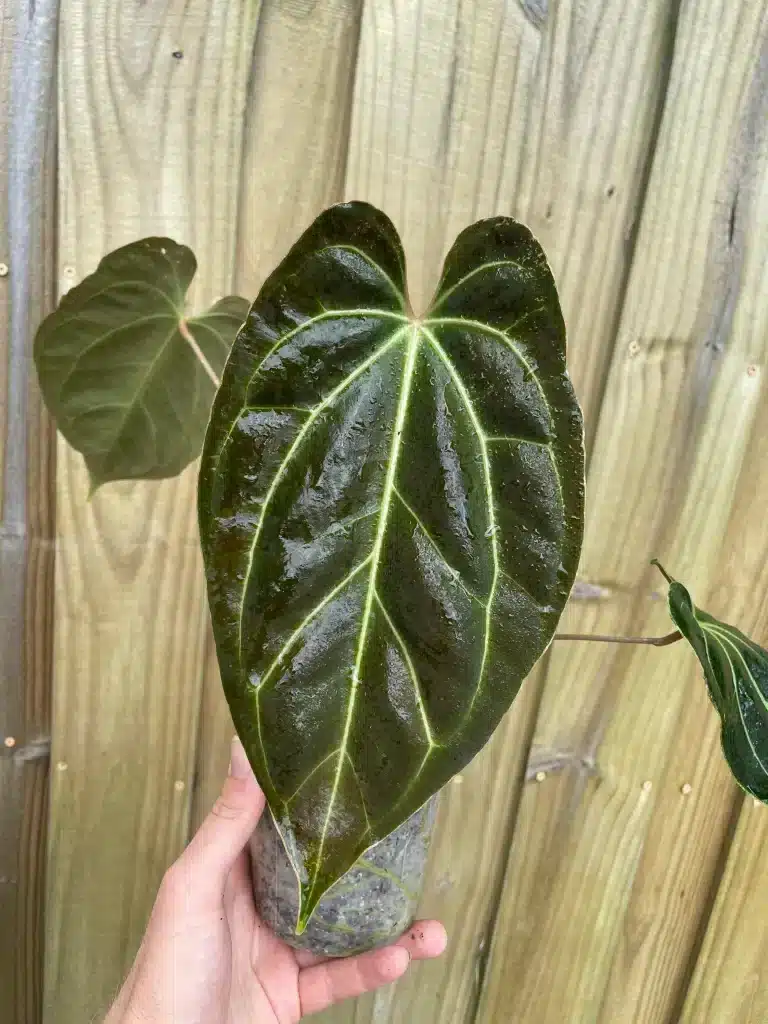
Anthurium besseae leaves are known for their dust-trapping and air-cleaning abilities.
The leaves are deep green in color with a bit shade of red. The significant part is the deep crystal veins that run through the leaves, giving it a mesmerizing look.
While looking individually, one single leaf can measure up to 30 inches in length. They produce red-colored spathe with a linear spadix every summer.
16. Anthurium Forgetii
Although their name is “forgetti,” this Anthurium variety is something you will not forget easily.
It has darker green-colored leaves with silver veins that add beauty to its charm. The leaves are shaped to look like a teardrop.
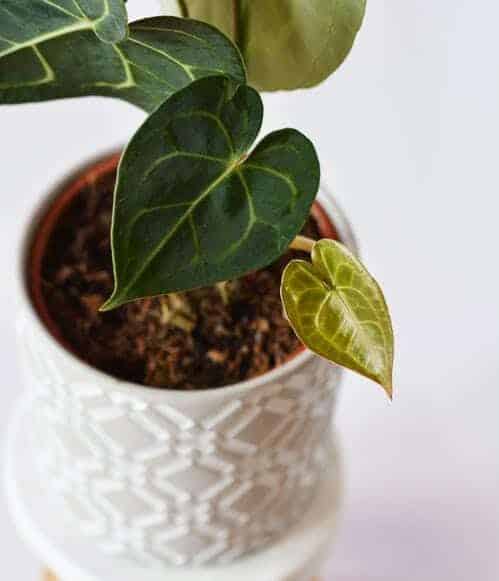
Keep this in mind, though! Forgetii takes a long time to grow. In their lifetime, the maximum they can increase is a height of up to 5 feet.
In the early stage of the plant, you will witness the sprouting and growth of leaves every month. The leaf of the healthy plant will grow to the width of 20-30cm.
You may be lucky if you see your forgetii bloom. Even if you get lucky enough, they will last just for a few months.
The bloom is similar to other Anthurium varieties; a spadix and a spathe.
17. Anthurium Andreanum
Also known as purple Anthurium, Anthurium andreanum is an exotic plant hailing from the Anthurium family.
The plant can grow up to 18 inches in height and 1 foot wide. They have medium-sized triangular leaves with rounded corners.
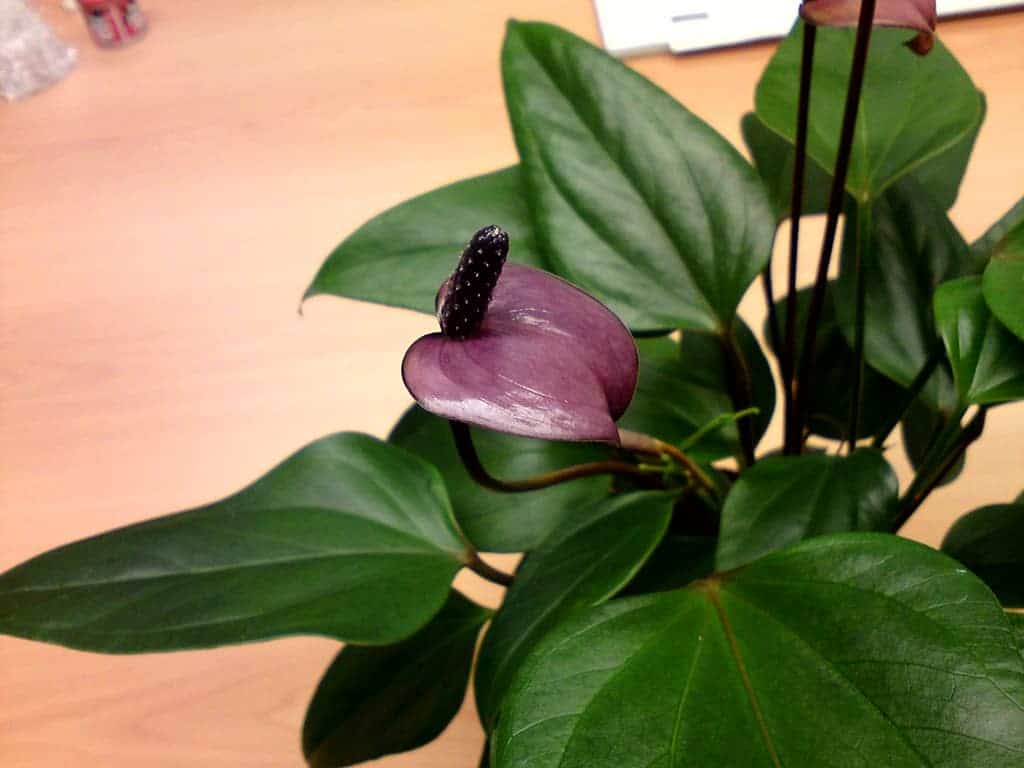
Like most Anthuriums, they also have a spathe or spadix.
Once they bloom, it lasts for nearly three months. Feed it with fertilizer rich in phosphorus if you want your plant to bloom.
Most people think that the waxy bracts are blooms of the plant, but they are not. Actually, the flowers grow on the spadix and are hard to observe.
18. Anthurium Angamarcanum
Like most Anthuriums, Anthurium angamarcanum also flaunts its big leaves. This plant grows at a slow pace and takes about 3 years to grow to its maturity.

If you provide this plant with excellent conditions, it will grow up to 4 to 5 inches.
The dark green-colored leaves have a velvety and shiny touch to them. And trust me when I say this: They have huge leaves.
Leaf blades in this plant can grow up to nearly 24 inches.
Though they are not so good to talk about, these plants do have a monocot bloom with a thin green-colored spathe.
You can choose to either cut the bloom or let them stay there for propagation via wind.
19. Anthurium Pedatum
Anthurium pedatum is another entry in the Anthurium’s long list of plants with strange structures. Just look at its foliage.
Pedatum is considered to grow slowly and takes a lifetime even to reach around 2-3 feet.

The bright green leaves are arranged in a claw-like structure and can expand to a width of almost 6 feet.
Strange fact: Anthurium pedatum leaves are heart-shaped when they are young and widen as they grow up.
These plants flower during spring and summer. It bursts out a green spathe that is 3-4 long.
The green color fades with time and changes to yellow. A purple spadix emerges around the spathe, attracting many pollinators.
20. Anthurium Wendlingeri
If someone asks you which is the most striking plant in the Anthurium category, you can show them Anthurium wendlingeri.
These plants have long, hanging, shiny, lush green leaves that charm the eyes.

They are shaped like pendants and boast a velvety surface that shines when exposed to the sun. In the name of veins, the leaves have creases on their surface.
The leaves can grow up to a height of 1.5 meters and a width of 12.7 centimeters.
They produce one of the most unusual inflorescences. The spathe is greenish-purple in color, and the spadix is whitish-gray.
The unusual thing about them is that the spadix is long and twisted. And the blooms live longer than other Anthurium varieties.
21. Anthurium Fingers
Looking at its name, you must have got an idea of what this plant looks like.
Anthurium finger’s leaves are lobed in the shape of fingers, and thus the plant gives the impression of an outstretched hand.

Anthurium finger is a fast-growing plant and will provide you with a good set of foliage in a year. The plant will grow up to the size of 1 meter.
The leaves will go from heart-shaped to fingers-shaped as they grow up. Sometimes there are even thirteen fingers.
Not much is known about their blooms, but they do produce flowers like other Anthuriums.
22. Anthurium Brownii
Well, just pronouncing the name may bring water to your mouth, but we are not talking about the edible “brownie”; this is toxic “brownii.”
Anthurium brownii has light green heart-shaped leaves and long petioles.
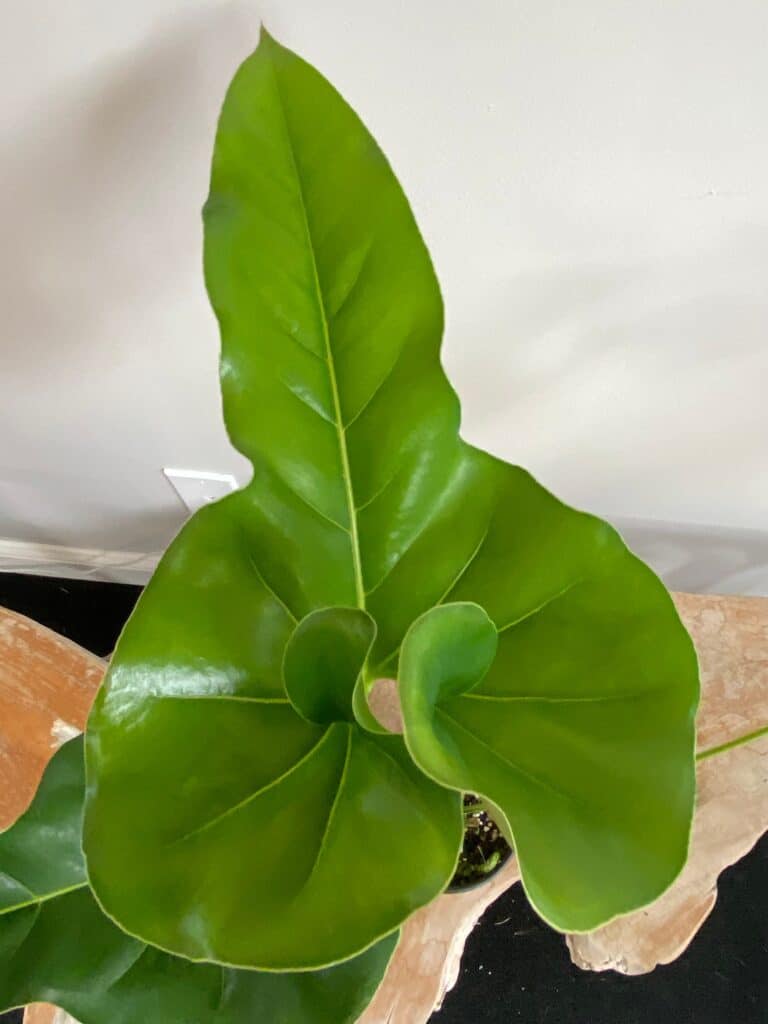
The leaves of this plant are light green, curvy at the edges, and ribbed at the surface. A new leaf will take about 2-3 weeks to grow to a significant size.
There is another good news; the leaves will not die in winter. However, their growth speed will slow down.
You will get to see the blooms with long spadix once a year. The spathe is red and gives a leathery look.
23. Anthurium Papillilaminum
Anthurium papillilaminum is considered one of the most beautiful Anthurium varieties ever to exist.
They have olive-green leaves that act as a great decorative addition to your home. Its magnificent leaves can grow up to the size of 90cm and has a leathery appearance.
The plant is a slow grower, and it grows only a few inches every late spring and summer.
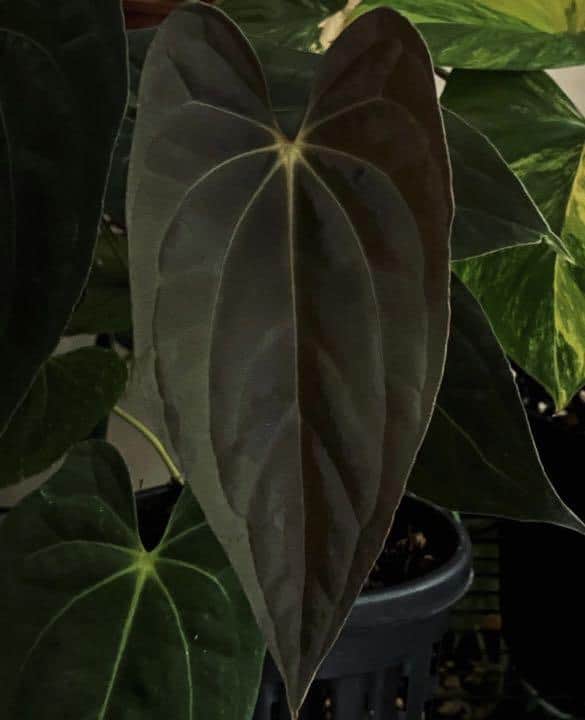
Anthurium papillilaminum has blooms that are easy to forget. They produce some flower-like spadix during spring and summer.
According to Exotica Esoterica, this plant has one of the most attractive leaves among foliage plants.
24. Anthurium Crystallinum
Anthurium crystallinum is a ‘gem’ of an indoor plant. 😉
This plant shows different growth phases. When it’s young, this plant grows faster, but that pace decreases as the plant grows up.
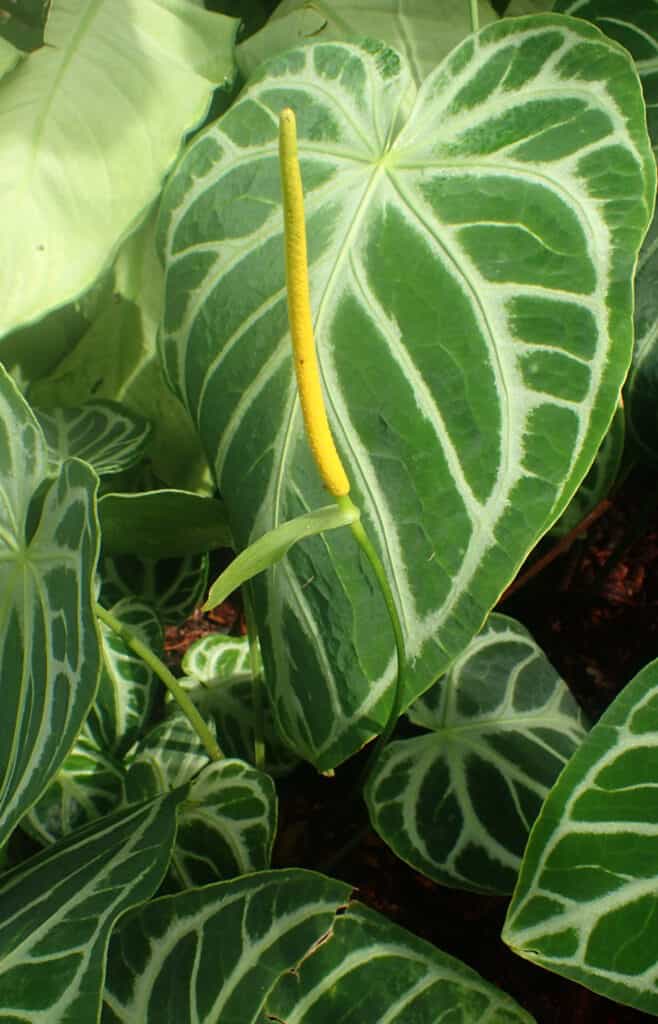
A grown-up crystallinum grows up to 50cm every 2 to 5 years. Not only that, but they also produce new leaves every 3 to 4 weeks.
While the whole plant gains a height of about 60 inches max, its width is about 18 inches. You may witness the leaf growth up to 90cm in its natural habitat.
Crystallinum produces flowers during the growing month, i.e., spring and summer. They consist of spadix and spathe. The spathe consists of tiny yellowish-greenish-white flowers.
25. Anthurium Hookeri
This Anthurium is one of the tiniest varieties of the Anthurium family. Anthurium hookeri has a growth height ranging from 4 inches to 2 ft in some cases.

It has triangular, D-shaped green-colored velvety leaves and can be up to 26cm wide and 89cm long.
As soon as you land your eyes on this plant, you will get a tropical vibe, thanks to its wrinkly leaves and lush green color.
Even if they are not famous for their blooms, the blooms exist. They have flowers with green spathe and purple hue. And their round-shaped seeds are white in color.
Some More Anthurium Varieties
| Varieties | Maximum Growth Size | Features |
|---|---|---|
| Anthurium coriaceum | Height: 4 feet Spread: 3 feet | Paddle-shaped, dark green leaves Inflorescence with dark-purple colored thick spathe and rachis |
| Anthurium warocqueanum | Height: 4 feet Spread: 6 feet | Lance shaped, dark green leaves, eye-catching white vein patterns with Green, Light Green, White color. |
| Anthurium Clarinervium | Height: 2.5 feet Spread: 2.5 feet | Heart-shaped, prominent white vein patterns on the leaf surface with dark green color. |
| Anthurium Gracile | Height: 2.95 feet Spread: 0.29 feet | Paddle-shaped, compact Aroid with glossy, elongated leaves with red to violet color. |
| Anthurium Amnicola | Height: 1 feet Spread: 2 feet | Tulip-shaped, brightly coloured, long-lasting flowers with pink to purple color. |
| Anthurium Superbum | Height: 3 feet Spread: 2 feet | Paddle-shaped ,thick, robust roots with dark green color. |
| Anthurium Radicans | Height: 1 feet Spread: 2 feet | Heart shaped, bullate yet deeply veined with pale maroon to purple spathe with a touch of green color. |
| Anthurium Pedatoradiatum | Height: 2.95 feet Spread: 0.59 feet | Heart-shaped .epiphytic or semi-epiphytic with fresh green color. |
| Anthurium Faustomirandae | Height: 3 feet Spread: 3 feet | Heart-shaped, leather-like leaves and white veins with green color with spadix of maroon color. |
Anthurium Varieties Care Hacks
The stunning decorative addition obviously will need more care and love. Don’t Panic!! Anthurium varieties are not so hard to care for, provided you are cautious enough.
Let’s look at some of the essential care guides.
- Anthuriums love when the temperature is warmer, i.e., between 75-85°F during the day and 70-75°F at night.
- These plants have fleshy, big roots that are prone to root rot if the soil is waterlogged. So, you should water the plant once a week.
- Compatible soil is essential for the efficient growth of a plant. You should go for coarse, well-draining potting soil for Anthurium varieties.
- Like most indoor plants, Anthurium varieties hate direct sunlight. They prefer medium to bright, indirect sunlight for efficient growth.
A research paper by iopscience.iop.org says, to increase the chlorophyll content in plants, you must keep them under the blue spectrum.
- Place the plant near an east-facing window to give it enough light to grow. Rotate it occasionally to ensure proper growth.
- Humidity should be above average, i.e., at least 50% or more.
- You should feed your Anthurium varieties with high phosphorus fertilizer diluted to 1/3rd strength every 3-4 months.
To Wrap it Up…
Also known as the “Flamingo flower,” Anthuriums have made their name among plant enthusiasts.
Also, thanks to the number of its varieties, you have a ton of Anthuriums to choose from for your home. May you choose the best one!


